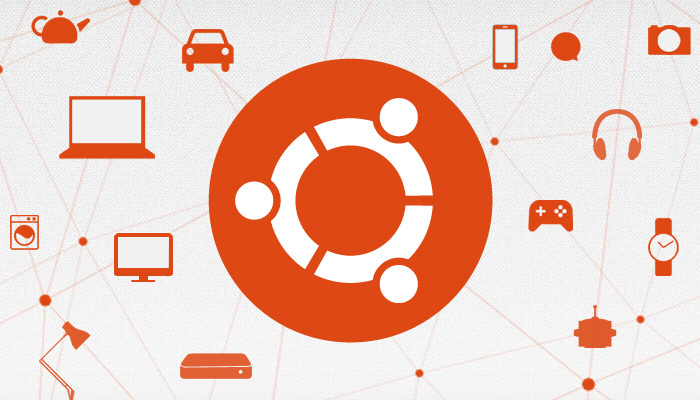
The Internet of Things promises to immerse us in a world of intelligent everyday objects, from self-regulating heating systems and chargers than know when your device is fully charged to weight-watching kettles to the cliched “internet refrigerator”.
Now Ubuntu is pitching with a plan to be the beating heart at the centre of this connected world.
Announced today is a version of Ubuntu Core — the smaller version of Ubuntu — for smart devices. The company say the tiny OS, which takes up just 40MB of RAM, will gift innovators, investors and early adopters with ‘the power of its cloud platform’ at the device level.
A number of open robotics projects and drones are already said to be using Ubuntu Core, with many more set to follow.
But just how is Ubuntu hoping to stand out in a vastly crowded crowded market?
The Internet of… What?
The Internet of Things (‘IoT’) is the idea in which everyday items are connected to and/or able to communicate with the web with the aim of making our lives easier.
Use cases range from kettles controlled by mobile phone apps and lightbulbs that turn off when a smart watch notices you’re asleep to autonomously powered drones and robots.
From Apple HomeKit, to Samsung’s SmartThings – whatever you can think of, chances are someone, somewhere is working on a way to shove wireless connectivity, sensors and a cloud-connected brain inside. The end goals range from simple “thing to thing” communication like a phone telling a wall charger it’s full, to loftier ambitions in which devices monitor us so they can adapt their behaviour to suit ours.
But there’s a problem in reaching any of this: fragmentation.
‘My Samsung Kettle Can’t Talk to My Sony TV’
The annual Consumer Electronics Show 2015 (CES) was awash with manufacturers, software vendors and Joe Attendees enthusing about the hyper-connected web we’ll be weaving around ourselves. OEMs talked up the use of open software stacks like Firefox OS, Tizen and Android on the client side of ‘things’, be it washing machines or TVs, but left preferences for the other half of the equation — the cloud — less distinct.
Standardisation is key. From interoperability to scalability to security, the IoT is only possible when devices are able talk to each other. And right now there’s no “one way” that happens.
Samsung CEO BK Yoon addressed this at CES 2015, stating that if some form of common standard can’t be reached through collaboration and cooperation then the segment is dead.
Enter Ubuntu, Linux and the “open” way of doing things.
Ubuntu’s Play for the Internet of Things
‘Snappy’ Ubuntu Core is Canonical’s hyper-minimal version of the Ubuntu OS with transactional, easily reversible updates and a tighter, mobile-esque security framework.
It’s already being talked up on the server side, where it can server as the remote computing that ties ‘things’ together. Now the tiny OS is pouching to become more than just the glue between the seams of ‘things’: it wants to the very foundation of devices themselves.
Ubuntu Core for Things gives device makers a consistent, dependable and easy updatable operating system on which to shape their ideas. It’s a single identical platform from cloud to device (convergence, yo) — a powerful proposition in a sector still squabbling over whose implementation should win out.
And that’s what makes Ubuntu’s play more appealing than, say Intel and Samsung’s Tizen: uniformity at all stages of the process: from development to deployment to updating. Custom firmware once specific to a single device would be replaced by a uniform operating system whose drivers and software can be updated securely from the cloud.
Snappy updates can be rolled back if something goes wrong – a vital crutch in updating millions of everyday things’
Ubuntu Core on a smart device has the same functions, APIs and security updates as the version running up in the cloud. Developers and inventors would be able build and prototype changes locally, using their own hardware, and then push their work outwards. Smart devices built on the platform will receive security updates automatically.
An open ‘app store’ will allow new features, functionality and hardware capabilities to be built, shared and deployed at any time.
The confined nature of ‘snappy’ updates makes them easily reversible should something go wrong. It doesn’t matter if you’re in charge of updating millions of smart ‘things’ or one very essential device, the chance to minimise the risk of failure is a super attractive pull.
Get Making
Ubuntu Core is well placed to help drive innovation in the mart device because of this unified, easily iterated platform. It makes it easy for mad hat inventors and technology conglomerates alike to test, build and publish new solutions on demand at scale. .
Ubuntu Core devices will requires a 600MHz processor with 128MB RAM and a 4GB flash for factory reset and system rollback. Ubuntu Core itself will only take up 40MB RAM leaving the rest for applications. A small number of boards and chipsets are supported at present, with plans for more to be added as the first stable release nears in April.
More details can be found at ubuntu.com/snappy
